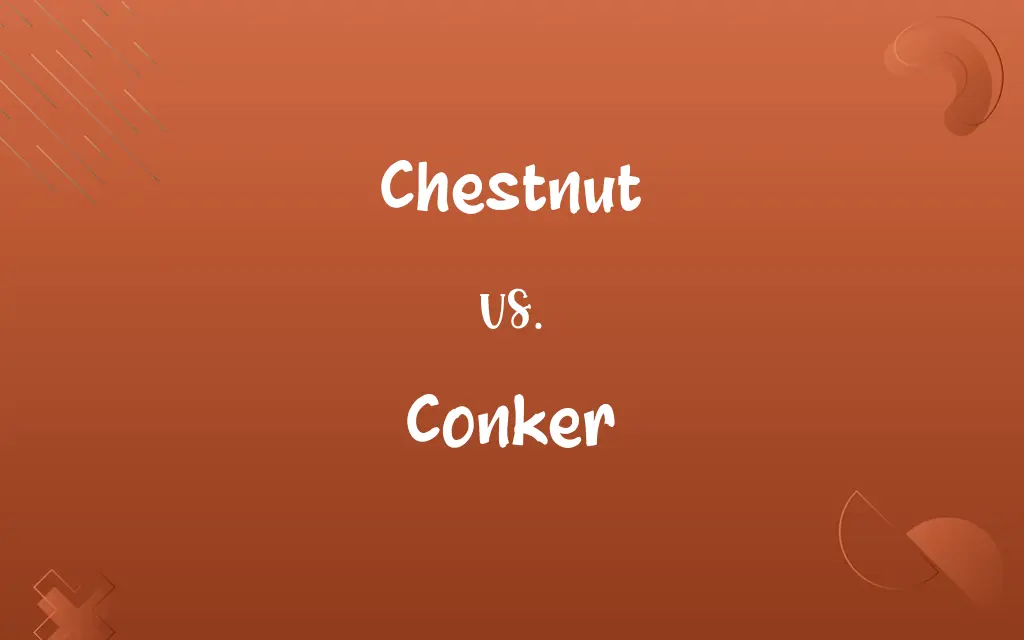Chestnut vs. Conker: Know the Difference

By Shumaila Saeed & Hifza Nasir || Updated on March 5, 2024
Chestnuts are edible nuts from Castanea trees, sweet and used in culinary dishes. Conkers are inedible seeds of the horse chestnut tree, Aesculus hippocastanum, used in games, not for eating.

Key Differences
Chestnuts, the fruit of Castanea species, are notable for their sweet, nutty flavor and are widely consumed, either roasted or incorporated into various dishes. They are enveloped in a spiny husk that splits open when ripe. Conkers, conversely, are the hard, shiny seeds of the horse chestnut tree, primarily known for their use in the children's game "conkers" rather than any culinary application, due to their toxicity to humans.
Shumaila Saeed
Mar 05, 2024
Culturally, chestnuts hold significant value in culinary traditions around the world, celebrated in autumnal feasts and recipes. Conkers, on the other hand, are embedded in British culture as a traditional autumn game, where children string them for competitive play, highlighting their cultural rather than nutritional value.
Hifza Nasir
Mar 05, 2024
From a nutritional perspective, chestnuts are rich in carbohydrates, fiber, and vitamins, making them a beneficial addition to the diet. Conkers, whereas, contain aesculin, a compound that is toxic to humans and animals, rendering them unsafe for consumption.
Shumaila Saeed
Mar 05, 2024
The trees that bear these seeds also differ markedly in their appearance and habitat. Chestnut trees are valued for both their fruit and durable wood, while horse chestnut trees are often planted for ornamental purposes, appreciated for their large, palmate leaves and showy spring flowers.
Shumaila Saeed
Mar 05, 2024
Despite sharing a similar name and the fact that both are encased in a prickly shell, chestnuts and conkers serve very different roles: one as a nutritious food source and the other as a component of play, underscoring their distinct places in nature and culture.
Dua Fatima
Mar 05, 2024
ADVERTISEMENT
Comparison Chart
Nutritional Value
High (carbohydrates, fiber, vitamins)
None (toxic compound aesculin)
Shumaila Saeed
Mar 05, 2024
Cultural Significance
Celebrated in culinary traditions
British children's game
Shumaila Saeed
Mar 05, 2024
ADVERTISEMENT
Appearance
Encased in a spiny husk, split when ripe
Hard, shiny, smooth surface
Hifza Nasir
Mar 05, 2024
Chestnut and Conker Definitions
Chestnut
Encased in a spiny husk that opens when ripe.
The ground was littered with split husks from ripe chestnuts.
Shumaila Saeed
Mar 05, 2024
Conker
The hard, shiny seed of the horse chestnut tree.
Children collected conkers for their school game.
Hifza Nasir
Mar 05, 2024
Chestnut
A sweet, edible nut from Castanea trees, often roasted.
Roasted chestnuts are a popular treat in the winter.
Hifza Nasir
Mar 05, 2024
ADVERTISEMENT
Conker
Contains toxic compounds making it unsafe to eat.
Despite their appeal, conkers are toxic and should not be ingested.
Dua Fatima
Mar 05, 2024
Chestnut
Celebrated in autumnal recipes and festivals.
The town's annual chestnut festival draws visitors from across the region.
Hifza Nasir
Mar 05, 2024
Conker
Part of traditional children's games in the UK.
Playing conkers is a cherished autumn tradition for many British children.
Dua Fatima
Mar 05, 2024
Chestnut
Rich in carbohydrates and vitamins.
Chestnuts are a good source of vitamins C and B6.
Dua Fatima
Mar 05, 2024
Conker
Used in the British game of conkers, not edible.
He won the conkers match with his unbeaten seed.
Shumaila Saeed
Mar 05, 2024
Chestnut
Used in culinary dishes for its nutty flavor.
She added chestnuts to the stuffing for extra flavor.
Shumaila Saeed
Mar 05, 2024
Conker
Ornamental trees that produce conkers are common in parks.
The horse chestnut tree by the library is full of conkers in autumn.
Shumaila Saeed
Mar 05, 2024
Conker
Con·kers A game in which two players swing horse chestnuts strung on string, with both players trying to use their own horse chestnut to shatter their opponent's.
Shumaila Saeed
Oct 19, 2023
Chestnut
The edible nut of a forest tree (Castanea vesce) of Europe and America. Commonly two or more of the nuts grow in a prickly bur.
Shumaila Saeed
Oct 19, 2023
Repeatedly Asked Queries
What is the game of conkers?
The game of conkers involves swinging a conker strung on a string to break an opponent's conker, a traditional children's game in the UK.
Shumaila Saeed
Mar 05, 2024
What are chestnuts good for?
Chestnuts are good for eating, either roasted or used in recipes, due to their sweet flavor and nutritional value.
Hifza Nasir
Mar 05, 2024
How do you identify a chestnut tree?
A chestnut tree can be identified by its long, toothed leaves, spiny husks on the ground, and sweet, edible nuts.
Shumaila Saeed
Mar 05, 2024
Is it safe to handle conkers?
Yes, it is safe to handle conkers, but they should not be ingested due to their toxicity.
Hifza Nasir
Mar 05, 2024
Can you eat conkers?
No, conkers are toxic to humans and should not be eaten.
Shumaila Saeed
Mar 05, 2024
Are chestnuts and conkers the same?
No, chestnuts are edible nuts from Castanea trees, while conkers are inedible seeds from the horse chestnut tree.
Hifza Nasir
Mar 05, 2024
What makes chestnuts a popular autumn food?
Chestnuts are popular in autumn due to their seasonal availability, sweet flavor, and use in traditional dishes and festivals.
Shumaila Saeed
Mar 05, 2024
Can chestnuts be found worldwide?
Yes, chestnuts are found worldwide, with species adapted to various climates, celebrated in many cultures for their culinary uses.
Shumaila Saeed
Mar 05, 2024
How long do conkers last?
Conkers can last for several months if kept dry, but they gradually lose their shine and may crack or decay over time.
Shumaila Saeed
Mar 05, 2024
How are conkers used if not eaten?
Conkers are primarily used for play in the game of conkers and sometimes for decorative purposes.
Shumaila Saeed
Mar 05, 2024
Can chestnuts be eaten raw?
Chestnuts can be eaten raw but are usually cooked to improve their texture and flavor.
Shumaila Saeed
Mar 05, 2024
Are there any health benefits to eating chestnuts?
Yes, chestnuts offer health benefits, including high fiber, low fat, and a good source of vitamins and minerals.
Shumaila Saeed
Mar 05, 2024
Why are conkers toxic?
Conkers contain aesculin, a saponin-type substance that is toxic to humans and animals, causing nausea and other health issues if ingested.
Dua Fatima
Mar 05, 2024
Do animals eat conkers?
While some animals may ingest conkers, they are generally toxic and can be harmful, so most wildlife avoids them.
Shumaila Saeed
Mar 05, 2024
What’s the difference between horse chestnut and chestnut trees?
Horse chestnut trees (bearing conkers) are ornamental with broad leaves and are toxic, while chestnut trees produce edible nuts and are valued for food.
Dua Fatima
Mar 05, 2024
Share this page
Link for your blog / website
HTML
Link to share via messenger
About Author
Written by
Shumaila SaeedShumaila Saeed, an expert content creator with 6 years of experience, specializes in distilling complex topics into easily digestible comparisons, shining a light on the nuances that both inform and educate readers with clarity and accuracy.
Co-written by
Hifza Nasir








































































